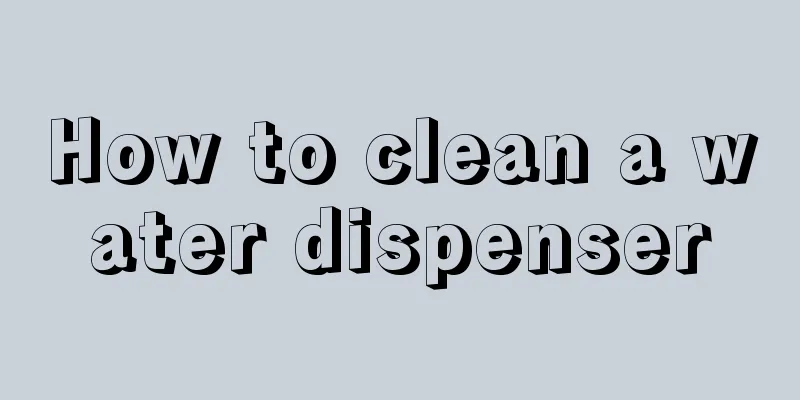How to clean a water dispenser

|
There is usually a water dispenser at home. Water dispensers allow us to drink healthier water and are also very convenient. Especially in companies, water dispensers are installed. However, although water dispensers seem to make the water we drink healthy and convenient, if they are not cleaned for a long time, the water quality will deteriorate. There are many water dispensers in homes that have not been cleaned for many years. How can the water be safe to drink? Today we are going to learn how to clean a water dispenser.
Everyone uses water dispensers in daily life, but let’s think about how many people clean the water dispensers regularly during use. If the water dispensers are not cleaned, the water quality may be polluted. Everyone must master the cleaning methods of water dispensers. Before giving the water dispenser a "bath", let's first introduce its structure and function: a water dispenser is usually made by turning the neck of a bottle of water upside down and placing it on the "smart seat" of the water dispenser. The hose inside the machine then guides the water into two water tanks, one of which is a hot water tank and the other is a cold water tank. In addition to discharging hot and cold water, these two water tanks can also precipitate impurities in the water. In life, people usually change bottled water repeatedly, but ignore the fact that there is still a certain amount of water in the inner tank of the water dispenser. This water may hide pathogenic bacteria, and over time, it becomes a breeding ground for bacteria. Therefore, if the hot and cold water tanks in the bottled water dispenser are not cleaned for three months, a large number of bacteria, viruses, precipitated residues, heavy metals and even red worms will multiply, seriously endangering people's health. Several steps to clean the water dispenser: 1. Unplug the power plug, remove the water bucket, open the drain pipe behind the water dispenser (usually a white plastic knob) to drain the remaining water. Then, turn on the hot and cold water switches to drain the water. The most noteworthy thing in this link is that the sewage pipe outlet of a vertical water dispenser is generally located at the back of the machine, while that of a desktop water dispenser is located at the bottom of the machine. Users have to lift up the desktop water dispenser to see it. 2. Rotate counterclockwise to remove the "smart seat" (the part of the water dispenser that contacts the spring water barrel), and use alcohol cotton to carefully wipe the inside and outside of the water dispenser tank and lid to prepare for the next step of disinfection. 3. Prepare disinfectant water according to the instructions of the decontamination effervescent tablets or disinfectant (decontamination effervescent tablets and special disinfectants are sold in supermarkets and are not expensive), introduce it into the water dispenser, allow the disinfectant water to fill the entire cavity, and leave it for 10-15 minutes. It is worth noting that if there are no effervescent cleaning tablets, disinfectants or disinfectant water, you can boil a pot of hot water, pipe the hot water into the water dispenser, and also leave it for 10-15 minutes. The purpose of this method is to kill the bacteria by high temperature. 4. Turn on all switches of the water dispenser, including the sewage pipe and drinking water switch, and drain the disinfectant or boiling water. To ensure that the disinfectant is completely drained out, try to rinse repeatedly with boiling water or purified water. 5. After rinsing several times, tilt the dispenser to the rear to drain any liquid that accidentally dripped in during the cleaning process, and wipe the outside and back of the dispenser with a dry cloth. 6. After the water dispenser is cleaned, there may still be a trace amount of water dispenser cleaning fluid remaining, so it cannot be drunk immediately. The water should be drained first and then it can be safely drunk until the discharged water has no chlorine smell. We cannot ignore the cleaning of water dispensers. Now we use water dispensers and drink bottled water for convenience, but don’t ignore cleaning the water dispensers for the sake of convenience. A lot of secondary pollution of bottled water is caused by water dispensers. Drinking unclean water has a great impact on our health. |
<<: The difference between a microwave oven and a light wave oven
>>: Very practical, 40 kinds of wonderful uses of beer that you don't know about
Recommend
Fried ice cream recipe
Today's times are getting better and better. ...
Can lecithin relieve hair loss?
Many people suffer from the problem of hair loss,...
Does drinking vinegar on an empty stomach hurt your stomach?
Vinegar is a very common condiment in cooking, an...
How to treat rhinitis caused by allergic mites?
Dust mite allergic rhinitis is a relatively commo...
What are some ways to prevent hair color from fading?
Nowadays, many young people like to dye their hai...
What proof is needed for induced abortion?
Many people may not know what induced labor means...
It would be best for people to learn to recognize the symptoms of pancreatic cancer
Pancreatic cancer is a type of cancer, which is a...
What are the effects of fragrant wood
Many people don’t know much about the fragrant wo...
What to do if you have a heat stroke
The temperature in summer is generally high regar...
Symptoms of paraquat poisoning
I believe that everyone is relatively unfamiliar ...
What to do if your facial skin is dull?
For most female friends, the most unacceptable th...
What is the treatment for acne?
Acne is clinically known as whiteheads, and some ...
"Leftover food" has nothing to do with "night"
The saying that "leftover vegetables cause c...
What causes excessive phlegm
The problem of excessive phlegm troubles many peo...
For the problem of hamartoma, choose a regular hospital for treatment
For the problem of hamartoma, choose a regular ho...









